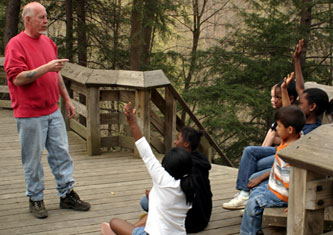 |
|
 |

| Student Behavior and Discipline
Afterschool and expanded learning programs often provide a more flexible learning environment than that of the regular school day. Although students and adults alike may enjoy this more relaxed setting, managing student behavior is still a crucial part of afterschool. However, not all staff may be trained in behavior management and discipline techniques or see students often enough to learn their behavior patterns. How can your afterschool program cultivate a flexible and stimulating learning environment while ensuring that freedom does not turn into chaos? Based on a 5-year study of high-quality afterschool programs, the following are some successful practices for managing discipline and student behavior. Have a discipline policy in place. If your program does not have a written discipline policy in place, consider adopting or adapting the school-day policy or the policy of another afterschool program. The discipline policy should include a process for addressing student behavior problems and have support from program leaders and staff. Educate the staff. Provide training to ensure that all staff members understand the discipline policy and how to interpret and implement it. Find mentors to provide guidance to staff who do not have training in managing students and discipline techniques. All staff need to know what to do and whom to contact when student behavior issues arise. Inform students and parents. Establish a process for informing students and parents of the program’s discipline policy. Students and parents need to understand the policy and the behavior expected of students. Work with the school-day staff. Establish a connection with school-day staff who can provide information about students should behavior issues arise. Support and cooperation can contribute to fewer discipline problems. Program leaders can work with school-day staff to build and maintain this cooperation. |
 Provide training to ensure that all staff members understand the discipline policy and how to interpret and implement it.
The SEDL National Center for Quality Afterschool helps state education agencies and local practitioners develop high-quality programs for academic enrichment as well as youth development activities. |

| 
A Resource Guide for Planning and Operating Afterschool Programs (3rd Edition) This product provides a description of resources to support afterschool and extended learning programs and is organized in the six areas necessary for the successful operation of afterschool programs: management, communication, programming, integrating K–12 and afterschool programs, community building/collaboration, and evaluation. The guide is available in print and online as a searchable database. |

|
Prevent Bullying During Afterschool
|
 |
 |
 |
||||||
Know Your Students
To learn more, see the strategy brief Reaching Out to Diverse Populations: What Can Schools Do to Foster Family-School Connections? |
|
|||||||
This e-mail was sent by: Editor: Laura Shankland
|
You are welcome to reproduce issues of AfterWords and distribute copies at no cost to recipients. Please credit SEDL as publisher. Link to PDF versions of AfterWords is available here. For additional uses, please fill out and submit a copyright request form. Copyright © 2009 by SEDL. |

